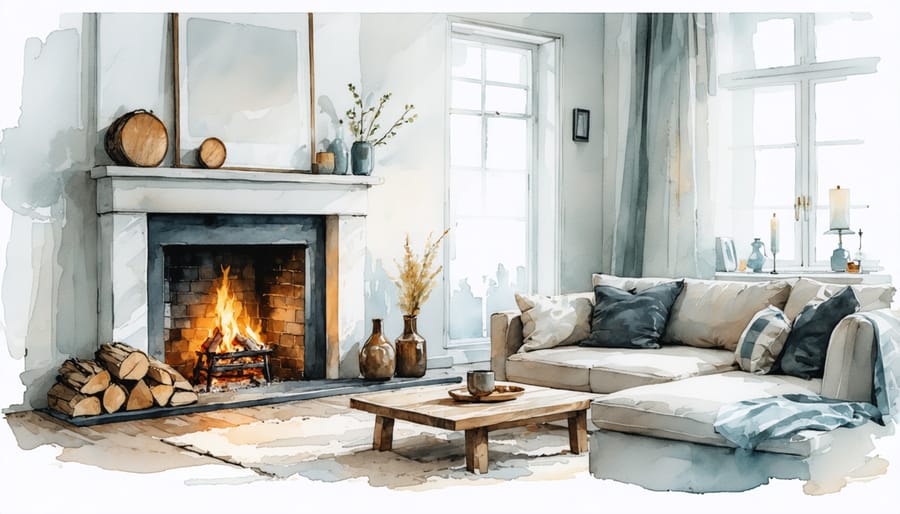
Create a Cozy Centerpiece: Step-by-Step Fireplace Build
Envision the warmth and ambiance of a wood burning fireplace in your home. With careful planning, the right materials, and some DIY know-how, you can get started building your own fireplace from scratch. Design your fireplace to fit your space, considering factors like room size, chimney placement, and local building codes. Source quality materials including firebrick, mortar, a lintel, and a well-fitted flue liner. Follow a detailed, step-by-step construction process, from laying the foundation to finishing the hearth and mantel, while prioritizing proper ventilation and adherence to safety standards. With dedication and attention to detail, you’ll soon enjoy the fruits of your labor – a beautiful, functional fireplace that serves as the heart of your home.

Planning and Design
Choosing the Right Location
When selecting the location for your wood burning fireplace, consider factors such as the room’s layout, size, and intended use. Ensure the fireplace is positioned away from high-traffic areas and flammable materials like curtains or furniture. Choose a central spot that allows for optimal heat distribution throughout the space. Consider the chimney placement and ensure it can safely exit through the roof or an exterior wall. Verify local building codes and obtain necessary permits before finalizing the location. Assess the structural integrity of the floor and walls to ensure they can support the fireplace’s weight. If you’re unsure, consult with a professional architect or structural engineer. For potential flooring concerns, you might want to learn about uneven floors and how to address them. Lastly, think about the fireplace’s aesthetics and how it will complement your interior design. With careful planning and consideration, you can select the perfect location for your wood burning fireplace that balances functionality, safety, and style.
Designing Your Fireplace
Designing your fireplace is an exciting step in the process of building a wood burning fireplace from scratch. Start by deciding on the overall style that best complements your home’s aesthetic, whether it’s a classic brick look, a sleek modern design, or a rustic stone facade. Consider the size of your fireplace in relation to the room it will be in – a larger space can accommodate a more grand and imposing fireplace, while a smaller room may benefit from a more compact and understated design.
Next, choose the materials you’ll use for your fireplace. Traditional options include brick, stone, and tile, each offering a unique look and feel. For a more contemporary vibe, consider using metal, concrete, or even glass. Keep in mind that the materials you select will impact not only the appearance of your fireplace but also its durability, maintenance requirements, and heat retention properties.
Don’t forget to think about the functional elements of your fireplace design as well. Determine the optimal firebox size based on the room’s dimensions and your heating needs. Select a chimney liner and flue system that’s appropriate for your fireplace size and local building codes. Finally, choose a mantel and hearth material that ties your design together while providing a safe and attractive surface for displaying decor and protecting your flooring.
By carefully considering your fireplace style, size, and materials, you’ll be well on your way to creating a beautiful and functional centerpiece for your home.
Gathering Materials and Tools
Before starting your wood burning fireplace project, it’s essential to gather all the necessary materials and tools. You’ll need a variety of supplies, including firebricks, mortar, a lintel, flue liner, chimney cap, and fireplace doors. Make sure to select high-quality, heat-resistant materials that meet local building codes and safety standards.
In addition to the main components, you’ll also require tools such as a tape measure, level, trowel, brick hammer, and masonry saw. A cordless drill, safety glasses, work gloves, and a dust mask are essential for your safety and comfort during the project.
When choosing firebricks, opt for dense, high-alumina content bricks that can withstand extreme temperatures. For the mortar, use a refractory mortar mix specifically designed for fireplaces. The lintel, which supports the bricks above the fireplace opening, should be made of steel or precast concrete.
The flue liner is a crucial component that helps protect your home from heat transfer and ensures proper ventilation. Choose a stainless steel or clay flue liner that matches the dimensions of your fireplace. A chimney cap, installed at the top of the flue, prevents moisture, debris, and animals from entering the chimney.
Lastly, select fireplace doors that complement your home’s style while providing a barrier against sparks and embers. With all these materials and tools on hand, you’ll be well-prepared to tackle your wood burning fireplace project with confidence.


Step-by-Step Building Process
Building the Foundation
Before you start building your wood burning fireplace, it’s crucial to create a sturdy foundation that can support the weight and heat of the structure. Begin by marking out the dimensions of your fireplace on the ground, ensuring it’s level and square. Excavate the area to a depth of at least 12 inches, then fill it with a layer of gravel for drainage. Next, build a wooden frame using pressure-treated lumber to create a mold for your concrete foundation. Mix your concrete according to the manufacturer’s instructions and pour it into the frame, ensuring it’s level and smooth. Allow the concrete to cure for at least 24 hours before proceeding. Once the foundation is set, you can start laying the first course of firebricks using refractory mortar. Take your time to ensure each brick is level and properly spaced. This solid foundation will provide a stable base for your fireplace, ensuring it remains safe and functional for years to come.
Constructing the Firebox
The firebox is the heart of your wood burning fireplace, where the actual fire will burn. Begin by laying a base of fire bricks, ensuring they are level and tightly fitted. Next, construct the walls of the firebox using fire bricks and refractory mortar, which can withstand high temperatures. As you build the walls, periodically check for level and plumb to maintain a stable, even structure.
When building the rear wall of the firebox, angle it slightly forward to help reflect heat into the room. This also promotes better drafting and reduces smoke spillage. Include a smoke shelf above the firebox to help guide smoke into the flue.
As you near the top of the firebox, use an angle iron to create a lintel that will support the weight of the bricks above the opening. Seal any gaps with refractory mortar to ensure a solid, heat-resistant structure.
Remember to leave an opening for the damper, which will allow you to control airflow and regulate the fire. The damper should be installed just above the firebox and below the smoke chamber.
With the firebox complete, you’re ready to move on to constructing the smoke chamber and flue. Take your time and double-check your work, as a well-built firebox is crucial for a safe and efficient wood burning fireplace.
Adding the Chimney
Adding the chimney is a critical step in ensuring your fireplace has proper and safe ventilation. Begin by measuring the flue liner to determine the size of the chimney. Cut a hole in the roof decking where the chimney will exit, then frame the opening with 2x4s. Install the chimney cap and fasten it securely. Next, build a chimney stack with bricks or stone veneer, ensuring it extends at least 2 feet above the roof line. As you lay the bricks or stone, integrate a clay flue liner in the center of the stack. Make sure to maintain proper clearances between the flue liner and combustible materials. Finally, apply mortar to seal any gaps and install a chimney crown to protect against water damage. Remember, a well-constructed chimney is essential for preventing smoke and carbon monoxide from entering your home, so take your time and follow best practices for a safe and efficient fireplace.
Finishing Touches
With the firebox, chimney, and surrounding structure complete, it’s time to add the finishing touches that will make your fireplace a stunning focal point. Start by installing the mantel, which can be a simple wooden beam or an ornate carved piece, depending on your style preferences. Secure it firmly to the wall above the firebox opening, ensuring it’s level and centered.
Next, lay the hearth stones or tiles in front of the firebox, creating a non-combustible surface that extends at least 16 inches from the fireplace opening. Choose materials that complement your mantel and overall room design, such as natural stone, ceramic tiles, or brick pavers.
Finally, personalize your fireplace with decorative elements that reflect your taste and style. Consider adding a classic fireplace screen to enhance safety and visual appeal, or display artwork, family photos, or treasured objects on the mantel. With these finishing touches, your custom-built wood burning fireplace will become a warm, inviting gathering spot for years to come.
Safety Considerations
When using your wood burning fireplace, always keep safety top of mind. Install smoke and carbon monoxide detectors near the fireplace and check batteries regularly. Use a fireplace screen to prevent sparks and embers from escaping. Never leave a fire unattended or let it smolder overnight. Burn only dry, seasoned wood to minimize creosote buildup in the chimney, which can lead to dangerous chimney fires.
Have your chimney professionally inspected and cleaned at least once a year before the burning season begins. Keep flammable materials like furniture, curtains, and decor at least three feet away from the fireplace. Teach children to stay clear of the fireplace and never leave them unsupervised around a burning fire.
When cleaning out ashes, wait until they’re completely cool and dispose of them in a metal container kept outside and away from flammable materials. With a gas starter, ensure connections are secure and the gas is turned off when not in use. By following these safety guidelines, you can enjoy the warmth and ambiance of your wood burning fireplace with peace of mind.
